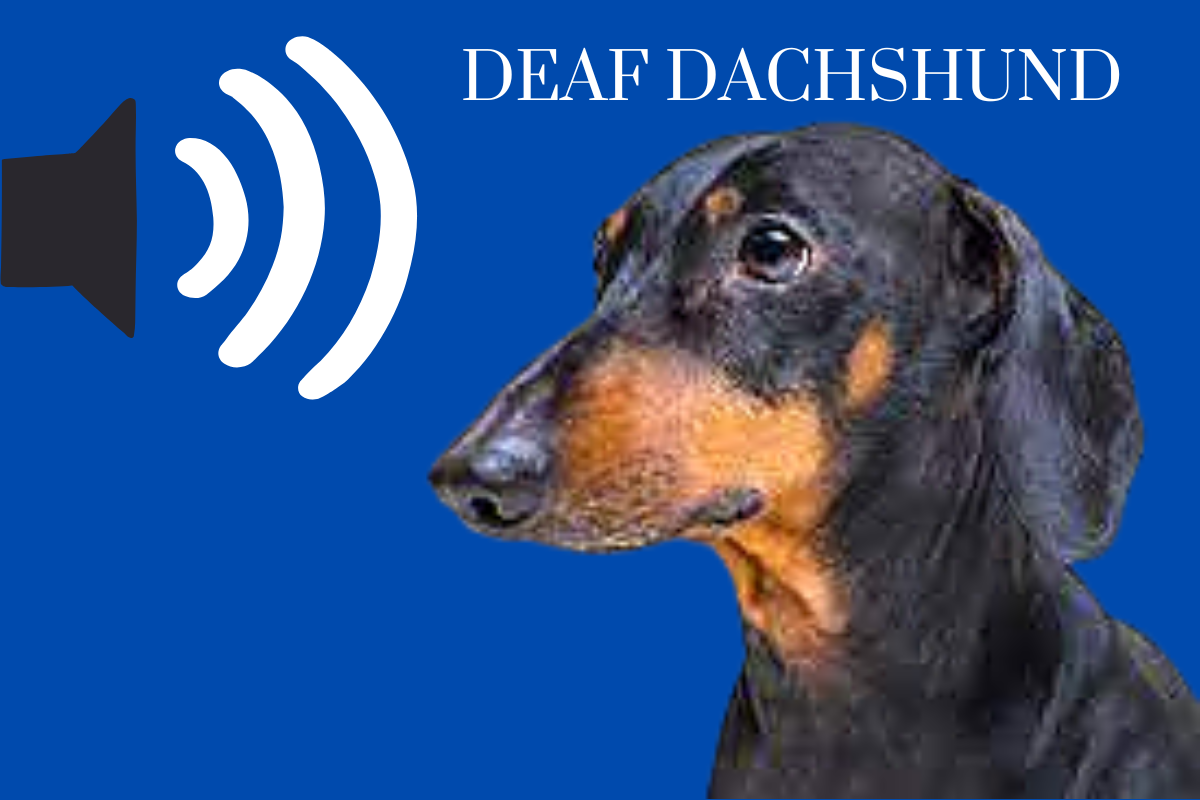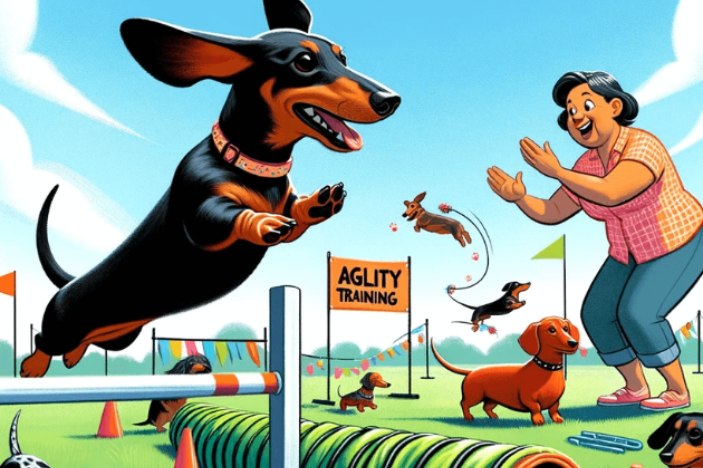Dachshund Deaf
Caring for a deaf dachshund requires a unique approach that addresses its specific needs. Deafness can be either congenital or acquired, but regardless of the cause, providing a safe, stimulating, and loving environment is crucial.
In this comprehensive guide, we will explore various aspects of caring for a deaf dachshund, including communication, training, safety measures, and overall well-being.
Understanding Deafness in Dachshunds:
It is important to first understand the nature of deafness in dachshunds. Deafness can be partial or total, affecting one or both ears.
While congenital deafness is often hereditary, acquired deafness can result from factors like age, infection, or injury. Recognizing signs of deafness, such as unresponsiveness to sounds, is crucial for early diagnosis and effective care.
Communication Techniques:
Since verbal commands are not effective, you need to establish alternative communication techniques with your deaf dachshund. Some practical methods include:
Hand Signals: Train your dachshund to understand a set of hand signals for basic commands such as sit, stay, come, and down. Consistency and positive reinforcement are key to successful training.
Visual Cues: Pair specific visual cues, such as clapping your hands or stomping your foot, with commands to gain your dachshund’s attention and indicate desired actions.
Vibrations: Deaf dachshunds are sensitive to vibrations. Utilize vibrations, such as tapping the floor or stomping your feet, to get their attention or signal an important message.
Training a Deaf Dachshund:
Training a deaf dachshund requires patience and creativity. Follow these guidelines to ensure effective training:
Positive Reinforcement: Use rewards, treats, and praise to reinforce desired behaviors. Positive reinforcement motivates your dachshund and fosters a strong bond between you.
Consistency: Establish a consistent routine and clear rules to help your dachshund understand expectations. Consistency in training methods and cues will lead to better understanding and response.
Visual Aids: Incorporate visual aids, such as flashcards or visual schedules, to reinforce training and help your dachshund understand routines.
Safety Measures:
Keeping your deaf dachshund safe is of paramount importance. Implement the following safety measures:
Secure Fencing: Ensure your yard has secure and sturdy fencing to prevent your dachshund from wandering off or getting into dangerous situations. Regularly inspect the fencing to identify any potential escape routes.
ID Tags: Equip your dachshund with proper identification, including a collar with tags containing your contact information. In case of accidental escape or separation, this will aid in their safe return.
Vibrating Collar or Harness: Consider using a vibrating collar or harness designed specifically for deaf dogs. These devices emit vibrations to get their attention, especially during outdoor walks or in emergency situations.
Mental and Physical Stimulation:
Deaf dachshunds, like any other dog, require mental and physical stimulation for their overall well-being. Engage in the following activities:
Interactive Toys: Provide interactive toys that engage their senses, such as puzzle toys or treat-dispensing toys. These toys offer mental stimulation and keep your dachshund entertained.
Enriching Walks: Take your dachshund on walks to explore different environments and encounter various stimuli. This allows them to engage their senses, experience new scents, and interact with their surroundings.
Training Games: Engage in training games and obedience exercises that challenge their cognitive abilities.
Use games like hide-and-seek, where you hide treats around the house or yard for your dachshund to find using their keen sense of smell.
This not only provides mental stimulation but also strengthens the bond between you and your furry companion.
Nose Work: Utilize your dachshund’s exceptional sense of smell by engaging them in nose work activities. Set up scent trails or hiding spots with treats or toys for them to search for.
This taps into their natural instincts and provides a mentally stimulating and rewarding experience.
Socialization: Introduce your deaf dachshund to other well-behaved dogs and people to promote socialization.
This can be done through supervised playdates or obedience classes specifically designed for deaf dogs.
Positive interactions with others contribute to their emotional well-being and help them build confidence.
Health Care:
Maintaining your deaf dachshund’s overall health is essential. Regular veterinary check-ups, vaccinations, and preventive treatments should be prioritized.
Pay attention to any signs of discomfort or health issues and seek immediate veterinary attention if needed.
Dental Care: Dachshunds are prone to dental problems, so regular brushing and dental check-ups are crucial for maintaining their oral health. Use dog-friendly toothpaste and a soft-bristled toothbrush to keep their teeth clean.
Grooming: Regular grooming sessions are necessary to keep your dachshund’s coat clean and healthy. Brush their fur to remove loose hair and prevent matting. Trim their nails regularly, ensuring you do not cut into the quickly.
Eye and Ear Care: Regularly inspect your dachshund’s ears for signs of infection, redness, or excessive wax build-up. Clean their ears using a veterinarian-recommended solution. Additionally, keep their eyes clean by gently wiping them with a damp, soft cloth.
Emotional Support:
Deaf dachshunds, like any other dog, require love, attention, and emotional support from their owners. Ensure you provide a nurturing and secure environment for your furry friend.
Establish Routines: Consistency and predictability in daily routines help deaf dachshunds feel secure. Set a regular feeding schedule, exercise routine, and designated rest areas to provide a sense of stability.
Physical Affection: Show physical affection through gentle touch, belly rubs, and massages. Physical contact can convey love and reassurance to your dachshund, strengthening your bond.
Visual Cues of Affection: Incorporate visual cues to express your affection. For example, use sign language for “I love you” or give them a gentle wave to indicate a positive interaction.
How do you potty train a deaf puppy?
Potty training a deaf dachshund requires a combination of consistent training methods and visual cues. Here’s a step-by-step guide to help you successfully potty train your deaf dachshund:
- Establish a Routine: Create a consistent schedule for your dachshund’s bathroom breaks. Take them outside first thing in the morning, after meals, before bedtime, and at regular intervals throughout the day. Consistency helps them develop a predictable routine.
- Choose a Potty Spot: Select a specific area in your yard where you want your dachshund to eliminate. The scent of previous eliminations can help them recognize the designated spot.
- Visual Cues: Instead of using verbal commands, establish visual cues to communicate with your deaf dachshund. For example, you can use a hand signal or a specific gesture to indicate that it’s time to go potty.
- Monitor Behavior: Pay close attention to your dachshund’s behavior and body language. Look for signs such as sniffing the ground, circling, or pacing, which indicate they need to relieve themselves.
- Timing is Key: Take your dachshund outside to the designated potty spot at the appropriate times, based on their routine and behavior. Be patient and give them sufficient time to eliminate.
- Reward and Positive Reinforcement: When your dachshund successfully goes potty in the designated spot, immediately praise them and provide a treat or a favorite toy as a reward. Positive reinforcement encourages them to repeat the desired behavior.
- Clean Accidents Properly: Accidents may happen during the potty training process. It’s essential to clean any indoor accidents thoroughly to remove the scent and discourage repeat incidents. Use an enzymatic cleaner specifically designed for pet messes to eliminate odors.
- Supervise and Restrict Access: When your dachshund is indoors, keep them in a confined area or use baby gates to restrict their access to the rest of the house. This helps prevent accidents and allows you to closely monitor their behavior.
- Be Consistent: Consistency is key in potty training. Stick to the established routine, cues, and rewards to reinforce the desired behavior. Avoid confusing your dachshund with mixed signals.
- Patience and Persistence: Potty training takes time and patience. Each dog learns at their own pace, so be prepared for occasional setbacks. Stay consistent, remain patient, and continue reinforcing positive behavior.
Remember, potty training requires time, effort, and consistency. With proper training techniques, positive reinforcement, and clear visual cues, you can successfully potty train your deaf dachshund and establish a strong foundation for good bathroom habits
Do deaf dachshunds make good pets?
Yes, deaf dachshunds can make excellent pets. While their deafness requires some adjustments in communication and training methods.
it doesn’t affect their ability to form strong bonds with their owners or their overall suitability as loving companions. With proper care, training, and understanding, deaf dachshunds can thrive in a supportive and nurturing environment.
How do you comfort a deaf dachshund?
Comforting a deaf dachshund involves utilizing visual cues and physical touch to provide reassurance and support.
Here are some ways to comfort your deaf dachshund:
Visual Cues: Use gentle hand gestures or visual signs of affection, such as a wave or blowing a kiss, to communicate your love and reassurance.
Physical Touch: Offer your dachshund gentle strokes, cuddles, or belly rubs. Physical contact can provide them with a sense of security and comfort.
Establish Routine: Maintain a consistent daily routine to help your dachshund feel secure and at ease. Predictability and stability contribute to their overall well-being.
Safe Space: Create a designated safe space for your dachshund, such as a cozy bed or a crate, where they can retreat when they need quiet and solitude. This allows them to feel secure in their environment.
Positive Reinforcement: Use positive reinforcement techniques, such as treats and praise, to reward your dachshund for calm and relaxed behavior. This encourages them to associate positive experiences with their surroundings and provides emotional comfort.
Do deaf dachshunds sleep more?
Deaf dachshunds do not necessarily sleep more solely because of their deafness. Like any other dog, their sleeping patterns can vary based on factors such as age, health, activity level, and individual preferences.
Generally, dachshunds tend to sleep between 12 to 14 hours a day, which is considered normal for most dogs.
However, if you notice a significant increase in sleep or any changes in your energy levels, it’s always a good idea to consult with a veterinarian to rule out any underlying health issues.
How do deaf dachshunds show love?
Deaf dachshunds can express love and affection in various ways, relying on visual cues, body language, and innate characteristics. Here are some common ways deaf dachshunds show love:
Physical Contact: Deaf dachshunds often enjoy physical contact and may seek out cuddling, leaning against you, or sitting on your lap as a way to express their love and bond with you.
Tail Wagging: Like all dogs, deaf dachshunds communicate through their body language. A wagging tail, coupled with a relaxed body posture, indicates happiness and affection.
Eye Contact: Deaf dachshunds may maintain eye contact with you, gazing into your eyes as a sign of trust, affection, and a desire for connection.
Playfulness: Deaf dachshunds may exhibit playful behavior, engaging in games, and offering toys as a way to interact with you and show their love.
Loyalty and Companionship: Deaf dachshunds are known for their loyalty and strong bond with their owners. They may choose to be in close proximity to you, following you around the house and seeking constant companionship.
Understanding your deaf dachshund’s unique ways of expressing affection and observing their individual behavior will help you recognize and appreciate the love they have for you.
Conclusion
Caring for a deaf dachshund requires patience, understanding, and a commitment to their unique needs.
By establishing effective communication techniques, implementing safety measures, providing mental and physical stimulation, and offering emotional support, you can ensure a fulfilling and enriching life for your furry companion.
Remember, with proper care, your deaf dachshund can lead a happy and healthy life, thriving in their environment with your love and support




